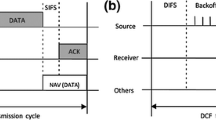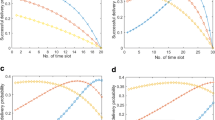Abstract
IEEE 802.11-based wireless networks are becoming more popular, and a lot of research is done to enhance the performance of the distributed control function (DCF) found in the IEEE 802.11 standard. Many researchers utilized jamming to further enhance the performance of the contention resolution in DCF. However, jamming-based protocols follow elimination schemes based on the use of jam signals which add to the complexity of wireless devices, add new types of errors like falsely detecting noise as a jam, and are not compatible with the IEEE 802.11 standard. In this paper we propose a self-elimination MAC protocol, called SEMP, for wireless networks to achieve a high performance like that of jamming-based protocols but without the use of jamming signals. SEMP requires no changes to the IEEE 802.11 physical layer, is fully compatible with the IEEE 802.11 wireless devices, and is designed to work without any prior knowledge of the number of nodes. Through extensive simulation, we evaluate SEMP and compare it to the IEEE 802.11 DCF and CONTI (a jamming-based protocol that was shown to highly improve the performance of the IEEE 802.11 wireless networks). Simulation results demonstrate that SEMP outperforms the IEEE 802.11 DCF in terms of the throughput, delay, fairness, and jitter. In addition, results show that SEMP provides throughput and delay gains over CONTI, and that both schemes have comparable fairness and jitter measures. Hence, results reveal that SEMP actually does achieve a high performance like CONTI even though no jamming is used.





















Similar content being viewed by others
References
IEEE Std 802.11b-1999, Wireless LAN medium access control (MAC) and physical layer (PHY) specifications: Higher-speed physical layer extension in the 2.4 GHz band.
IIEEE Std 802.11a-1999, Part 11: Wireless LAN medium access control (MAC) and physical layer (PHY) specifications—Amendment 1: High-speed physical layer in the 5 GHz band.
IEEE Std 802.11g-2003, Part 11: Wireless LAN medium access control (MAC) and physical layer (PHY) specifications—Amendment 4: Further higher data rate extension in the 2.4 GHz band.
IEEE Std 802.11e-2005, Part 11: Wireless LAN medium access control (MAC) and physical layer (PHY) specifications—Amendment 8: Medium access control (mac) quality of service enhancements.
IEEE Std 802.11n-2009, Part 11: Wireless LAN medium access control (MAC) and physical layer (PHY) specifications—Amendment 5: Enhancements for higher throughput.
IEEE Std 802.11-2012. (2012). Part 11: Wireless LAN medium access control (MAC) and physical layer (PHY) specifications.
IEEE Std 802.11ac-2013. (2013). Part 11: Wireless LAN medium access control (MAC) and physical layer (PHY) specifications: Enhancements for very high through-put for operation in bands below 6 GHz.
Heusse, M., Rousseau, F., Guillier, R., & Duda, A. (2005). Idle sense: an optimal access method for high throughput and fairness in rate diverse wireless LANs. ACM SIGCOMM Computer Communication Review, 35(4), 121–132.
Anouar, H., & Bonnet, C. (2007). Optimal constant-window backoff scheme for IEEE 802.11 DCF in single-hop wireless networks under finite load conditions. Wireless Personal Communications, 43(4), 1583–1602.
Al-Mefleh, H., & Al-Kofahi, O. (2016). Taking advantage of jamming in wireless networks: A survey. Computer Networks, 99, 99–124.
Abichar, Z., & Chang, J. (2005). Conti: Constant-time contention resolution for WLAN access. In NETWORKING 2005. Networking technologies, services, and protocols; Performance of computer and communication networks; Mobile and wireless communications systems. Lecture notes in computer science (vol. 3462, pp. 358–369).
Abichar, Z., & Chang, J. (2011). A medium access control scheme for wireless LANs with constant-time contention. IEEE Transactions on Mobile Computing, 10(2), 191–204.
Patel, P., & Lobiyal, D. K. (2015). A simple but effective contention aware and adaptive back-off mechanism for improving the performance of IEEE 802.11 DCF. Wireless Personal Communications, 83(3), 1801–1841.
Zhou, B., Marshall, A., & Lee, T.-H. (2007). A k-round elimination contention scheme for WLANs. IEEE Transactions on Mobile Computing, 6(11), 1230–1244.
Wikstrand, G., Nilsson, T., & Dougherty, M. (2008). Prioritized repeated eliminations multiple access: A novel protocol for wireless networks. In INFOCOM 2008. The 27th conference on computer communications. IEEE.
Sen, S., Choudhury, R. R., & Nelakuditi, S. (2011). Listen before you talk, but on the frequency domain. ACM SIGMOBILE Mobile Computing and Communications Review, 14(4), 7–9.
Roman, B., Stajano, F., Wassell, I., & Cottingham, D. (2008). Multi-carrier burst contention (mcbc): Scalable medium access control for wireless networks. In Wireless communications and networking conference, 2008. WCNC 2008. IEEE (pp. 1667–1672). IEEE.
Tan, K., Fang, J., Zhang, Y., Chen, S., Shi, L., Zhang, J., et al. (2011). Fine-grained channel access in wireless LAN. ACM SIGCOMM Computer Communication Review, 41(4), 147–158.
Fang, J., Tan, K., Zhang, Y., Chen, S., Shi, L., Zhang, J., et al. (2013). Fine-grained channel access in wireless LAN. IEEE/ACM Transactions on Networking (TON), 21(3), 772–787.
Sarkar, T. K., & Bodas, T. (2013). A FICA based contention scheme for WLAN with non cooperation. In 2013 National conference on communications (NCC) (pp. 1–5). IEEE.
Sen, S., Roy Choudhury, R., & Nelakuditi, S. (2011). No time to countdown: Migrating backoff to the frequency domain. In Proceedings of the 17th annual international conference on mobile computing and networking (pp. 241–252). ACM.
Feng, X., Zhang, J., Zhang, Q., & Li, B. (2012). Use your frequency wisely: Explore frequency domain for channel contention and ACK. In: INFOCOM, 2012 Proceedings IEEE (pp. 549–557). IEEE.
Lu, F., Voelker, G. M., & Snoeren, A. C. (2015). Managing contention with Medley. IEEE Transactions on Mobile Computing, 14(3), 579–591.
Yin, J., Mao, Y., Leng, S., Jiang, Y., & Khan, M. A. (2015). Access granularity control of multichannel random access in next-generation wireless LANs. Computer Networks, 91, 135–150.
Sobrinho, J., & Krishnakumar, A. S. (1999). Quality-of-service in ad hoc carrier sense multiple access wireless networks. IEEE Journal on Selected Areas in Communications, 17(8), 1353–1368.
Haas, Z., & Deng, J. (2002). Dual busy tone multiple access (DBTMA)—A multiple access control scheme for ad hoc networks. IEEE Transactions on Communications, 50(6), 975–985.
Leemis, L., & Park, S. K. (2006). Discrete-event simulation: A first course. Upper Saddle River, NJ: Prentice-Hall.
Kabir, A., Alam, M., Ahmed, L., Sabah, S., & Ferdous, H. S. (2012). Performance comparison of medium access control schemes for IEEE 802.11. In 2012 18th Asia-Pacific conference on communications (APCC) (pp. 652–657). IEEE.
Jain, R. K., Chiu, D. R., & Hawe, W. (1984). A quantitative measure of fairness and discrimination for resource allocation in shared computer systems. DEC Research Report TR-301.
Huang, C.-L., & Liao, W. (2007). Throughput and delay performance of IEEE 802.11e enhanced distributed channel access (EDCA) under saturation condition. IEEE Transactions on Wireless Communications, 6(1), 136–145.
Raptis, P., Vitsas, V., Chatzimisios, P., & Paparrizos, K. (2007). Delay jitter analysis of 802.11 DCF. Electronics Letters, 43(25), 1472–1474.
Hassan, M., Nayandoro, A., & Atiquzzaman, M. (2000). Internet telephony: Services, technical challenges, and products. IEEE Communications Magazine, 38(4), 96–103.
Author information
Authors and Affiliations
Corresponding author
Rights and permissions
About this article
Cite this article
Al-Mefleh, H. SEMP: Self-Elimination MAC Protocol for IEEE 802.11 Wireless Networks. Wireless Pers Commun 94, 755–776 (2017). https://doi.org/10.1007/s11277-016-3649-2
Published:
Issue Date:
DOI: https://doi.org/10.1007/s11277-016-3649-2




